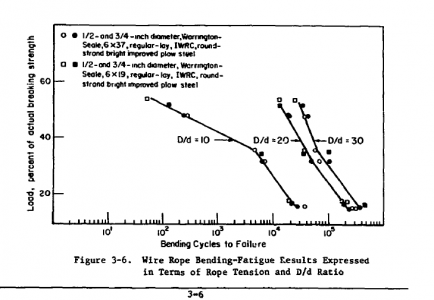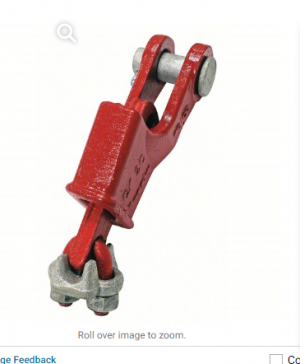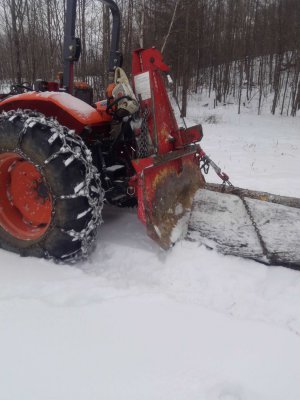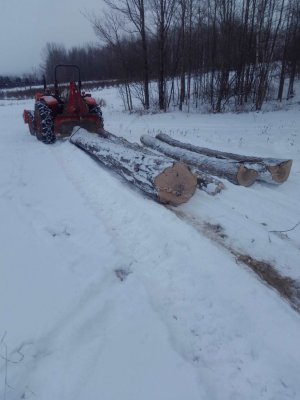Jake, that is an excellent observation, I have gone down a bit of a rabbit hole on the internet and found US Navy Wire Rope Handbook vol 2 1987, there is a chart that shows rope fatigue life vs sheave/rope diameters (D/d). For example when a rope is loaded at 50% of its strength, the bending life goes from about only 300 cycles at D/d=10 to about 20,000 cycles at D/d=20 and 40,000 cycles at D/d=40 (corresponding to sheave or drum diameters of 5, 10 and 20" with 1/2 cable).
Be careful with that. I doubt it's inaccurate, but that is based on two things that might make it misleadingn- A, it's logarithmic, obviously. B, it's based (or biased) towards unrealistic percentages of break strength. Hold on to that thought for a minute...
You've got a cable that without knowing specifics has a break strength way over 30,000 pounds. Probably closer to 35,000 pounds. Rough numbers, 50 percent of that puts you at 15,000 pounds with a 2:1 safety factor. The cable it's self is probably rated at 3 or 4 to one. More likely three, somewhere in the ballpark of 10,000 pounds, if they chose to rate it. If it's meant for logging, they may not have assigned a working load.
You've got a winch that's good for mid eleven's you said, on the bottom wrap? That's 30 percent of break strength with a good margin in your favor.
You've got a winch that is rated with a suitable pulling effort with the cable wrapped onto it, where it's maximum force is far,far less.
In practice, unless you have the wrong winch, even as you pull a hitch all the way in, maximum cable layers on the drum, it's gonna do what you need, right? The load will be WAY less than what the winch is capable of...
Now, back to that logarithmic scale on the number of cycles on their cable,
At 50 percent of break strength, you were in the 300 cycle range. At 40 percent of break strength you've cleared eleven hundred. At 30 percent (kind of where your winch maxes, on the lowest wrap), you at seven or eight thousand cycles. At 25 percent you've cleared ten thousand cycles.
In practice (based on the winch ratings, I've got no idea what your sense of adventure is), aside from some short lived hangups, you're going to spend the bulk of your winching time well under twenty percent of the break strength. So again, that logarithmic graph... If you look at the bottom of the graph lines, they don't connect the dots, they scatter, and in general, they start to head east just under 20 percent... That's where you'll be working most. And your hangups will be on one spot or another in the rope for load cycling purposes, not on a continuous pull (probably a loop) as the graph indicates. So the higher load cycling will be more reflective of the number of times you pull hard on the SAME SPOT in the cable, versus the whole cable wearing.
Bottom line- while that chart appears to be accurate based on my experience, I don't think fatigue is going to be your issue. That's why loggers tend to use oversized, often overrated stuff. Because it gets broken, mistreated, and abused. That cable could be 50 percent destroyed, and still be stronger than your winch.
If I use the snatch block on the winch, the D/d is only about 8 using 1/2" cable and 11 if I drop down to the 3/8 cable.
The break strength on that I think is 18,000 and maybe some change. (You are talking about swaged cable there too, right?). So take the difference in break strength, between 18K and ket's say 32K for argument's sake, run those numbers back up and down a couple of snatch blocks and wind them up on a drum... I'll bet the higher cable wear from a small sheave and drum doesn't look nearly as bad as running a cable at that much higher of a percent of it's break strength.
Good point on the anchoring, its probably a good idea to always leave several turns on the drum so friction between the rope and drum will result in less force on the anchor of the cable to the drum.
Four turns at an absolute minimum, five is a much more common callout in this size range.
I'm not worried about you pulling a rope out of the anchor. That's annoying, depending who sees you do it it could be embarrassing, but it's ALL going AWAY from you, and if somebody's standing over the rope downstream from you (then shame on both of you, but that's another story), it will let go with a force that doesn't do the things that horror stories are made of. It's not strong enough to impart any tangible stretch in the system, so it doesn't store that much energy in the cable. My concern with the anchors is that it collects ALL of the strands in the cable and retains them by some reasonable means. When one of the strands (the small "ropes" that you can see from the outside) becomes unsupported, it will have a propensity to displace from the bundle (the rope), and ruin the geometry that lets these things do their magic. Through a pile of cascading events, it makes a dangerous, weak cable with a lowered breaking point, that IS capable of getting high stretch out of lesser pulling forces... That's the part about the anchor that bothers me. Even though it's low force at that point, it's got to hold the cable together and in shape.





